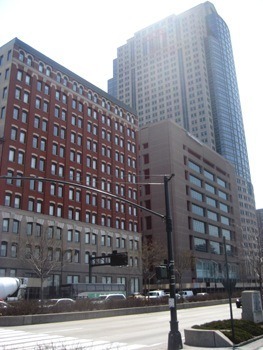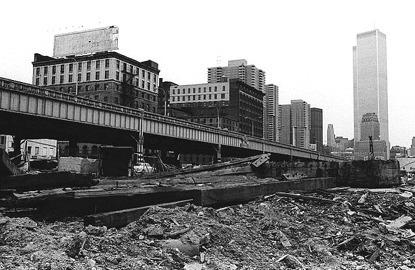The Business of Art: In New York, the Price Is Not Right
Allan Tannenbaum. View of Tribeca from the West Side Highway. 1974.
There was a time not so long ago in New York City, as NYFA’s Executive Director Michael Royce remembers here, when it was possible for artists to congregate in neighborhoods like SoHo, DUMBO, the East Village, Tribeca, and Williamsburg. While occasionally dangerous and routinely short on amenities, areas like these offered artists affordable live/work spaces and the potential to surround themselves with a community of peers. In this article, Royce surveys how a rabidly speculative real estate landscape that lacks a vision for sustainable housing solutions for artists endangers New York City’s status as a viable center for creative communities.
At 18, I did what many aspiring artists do. I came to New York to obtain an education, learn my craft, and find a community of like-minded people. On my first day, I went to a bank, took out a substantial loan, and enrolled myself in New York University’s Tisch School of the Arts acting program. When my freshman year was over, I went home for the summer. It was extremely uncomfortable. Neither my father nor I wanted to be in the same room with the other.
A little over a year later, I saw a posting on a NYU bulletin board for a very cheap dwelling. I moved in. It was a three-room, heat-free apartment with communal bathing facilities only. I roomed with a woman and her dog. The whole apartment was smaller than most living rooms. I didn’t stay long.
I then schlepped to the Upper West Side. During this era, the price was right, and this time I would have my own bathroom, a big step up. However, noise was a problem. My roommate, a male model, often returned home with a rotating cast of partners and engaged in passionate vocal play. My stay was even shorter.
Around this same time, I was partnered with a woman at an improv audition. She had no money and needed a roommate. I had some pocket change and needed a place to hang my hat. We connected. For a while, things seemed perfect. But after being mugged at knifepoint and later walking in to find all of my possessions taken, I moved again. Only this time, she came with me. We found another place a few buildings west. Domestic bliss was short-lived. A stranger kicked in our window in the middle of the night to gain entrance. She moved out the next day.
I finally settled into a place in a tough neighborhood. I heard gun shots, I heard people being assaulted, and people lined up in the hallway waiting to buy drugs. I stayed in that building for 17 years for one reason: I could be part of the theatrical community and still pay the rent. My craft did not require a live/work space that was versatile or had large areas for sculpting or painting, or sprung hardwood floors for dancing, or soundproof interiors for making music. But even if it did, those places could be found throughout the 1970s and 1980s in eerily empty industrial zones like SoHo or grimy but cheap neighborhoods like the Lower East Side. This enabled me and others to live amongst ourselves and form communities. Things are different now. Today, the costs of housing are so high that even “cheap” places in remote neighborhoods are expensive.
As the Executive Director of a leading national arts organization with personal experience seeking inexpensive apartments in the New York City of the past, the question I continue to ask myself and others is this: If this city is to continue to preclude dynamic artmaking communities from living here and forcing out those that do, then what will the New York City of the future look like?
New York, like many great urban cities, remains competitive due to a variety of factors, with stimulating and engaging cultural access being one of them—but if it doesn’t provide affordable live/work space opportunities specifically for artists, these communities will be forced to relocate. Do we really want to risk losing the individuals, communities, and creative industries that help to define what New York is all about simply because we haven’t come up with housing alternatives?

Nick Stillman. View of Tribeca from the West Side Highway. 2007.
If our artists go, then so do the businesses that use their talent. The Center for an Urban Future’s 2005 report Creative New York noted that the city’s “creative core” consists of 11,617 businesses and nonprofits. It also stated that 8.3 percent of all creative sector workers in the US are based in New York City, a figure bested only by London. Creative New York followed a 2001 publication by NYFA called Culture Counts. Working with cultural leaders, NYFA’s study delved into the relationship of the arts to the city’s ecosystem. What we found is that there is a need for cultural investment because the return on investments for education, jobs, tax revenue, and the quality of life was, and is, extraordinarily high.
Unsurprisingly, we also discovered an urgent need for affordable space of all kinds to ensure New York’s vitality. Various strategies were suggested to address fundamental problems of the rising real estate market, yet little has been done for the artists’ community to offset this reality. It is my fear that unless there is a groundswell of activism by and for artists on the housing issue, the problem will only worsen.
Government is only one part of the solution. The other parts will come from businesses, civic leaders, and artists themselves. In New York, we have a mayor who understands the need for affordable housing. Under New York City Mayor Michael Bloomberg, 55,000 units of affordable housing have now been funded, one-third of a 165,000 unit plan. The $7.5 billion plan is the largest municipal affordable housing plan in the nation’s history and will build and preserve affordable housing for 500,000 New Yorkers over ten years. However, unless other stakeholders who benefit from cultural sustainability come to the table on this issue with greater frequency and more urgency, spaces that are either designed, built, or occupied by artists to ensure that New York continues to be seen and experienced as the cultural capital of the world may not be realized. Then where will we be?
Last month, NYFA began a listening tour around the state of New York. We are partnering with local arts councils and arts organizations and reaching out to individual artists to create focus groups. With the assistance of a professional facilitator, we hope to obtain a better understanding of the most important needs, challenges, and obstacles faced by artists today. We think it is important to hear from artists first before developing any new strategic plans for programs and opportunities that will serve them. I am committed to having NYFA serve artists in ways that are critical to their success, but we can’t do it alone. We need your feedback. I look forward to meeting some of you during our canvassing and welcome your thoughts on the subject matter.





